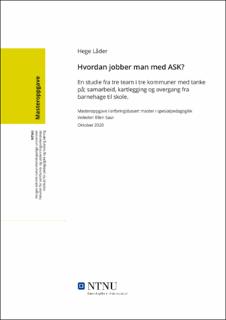| dc.contributor.advisor | Saur, Ellen | |
| dc.contributor.author | Låder, Hege | |
| dc.date.accessioned | 2021-09-28T17:26:08Z | |
| dc.date.available | 2021-09-28T17:26:08Z | |
| dc.date.issued | 2020 | |
| dc.identifier | no.ntnu:inspera:65687640:27755810 | |
| dc.identifier.uri | https://hdl.handle.net/11250/2784344 | |
| dc.description.abstract | Sammendrag
Formålet med studien har vært å få innblikk i tre tverrfaglige team sine erfaringer med fagområdet alternativ og supplerende kommunikasjon (ASK). Problemstillingen som danner utgangspunktet for studien, er som følger:
Hvordan jobber man med ASK?
En studie fra tre team i tre kommuner med tanke på; samarbeid, kartlegging og overgang fra barnehage til skole.
For å avgrense og belyse problemstillingen nærmere er det utarbeidet tre forskningsspørsmål. Forskningsspørsmålene omhandler hvilke systemer har de ulike kommunene når det gjelder: kartlegging av behov for ASK, på hvilke måter jobbes det med ASK i forhold til språk og kommunikasjon og hvordan sikres overgangen fra barnehage til skole.
Studien er basert på en kvalitativ forskningsmetode med fokusgruppeintervju som datainnsamlingsmetode. I studiens teorigrunnlag har jeg gått gjennom forskjellige lovverks betingelser, definisjonen på ASK, kommunikasjon, tverrfaglig samarbeid, kartlegging av ASK-behov samt overgangen fra barnehage til skole.
Resultatene viser at informantene har en relativ god forståelse når det gjelder alternativ og supplerende kommunikasjon, både når det gjelder kunnskap og i arbeid med barn.
Resultatene viser også at det ikke foreligger noen skriftlige prosedyrer når det kommer til kartlegging, evaluering og tiltak. Det er en god del ulike tiltak og oppfølging i overgangen fra barnehage til skole, men informantene sier det foreligger ikke noen skriftlige prosedyrer på hvem som har ansvar for hva. Dette viser til at det kunne vært hensiktsmessig å ha skriftlige prosedyrer over fordeling av ansvarsområder i et tverrfaglig samarbeid. Dette er viktig for å sikre barnet et tilpasset ASK program til å hjelpe dem å lære språk og kunne kommuniserer med sine jevnaldrende og har en glatt overgang til skolen.
Det som gjenspeiler teamene, er at deler av arbeidet med alternativ og supplerende kommunikasjon (ASK) er erfaringsbasert og avhengig av person. Dokumentasjon vil hjelpe å gjøre arbeidet mindre personavhengig, og gir et skriftlig program som kan følges av alle som jobber med barnet.
Nøkkelord: alternativ og supplerende kommunikasjon, tverrfaglig samarbeid, samarbeid. | |
| dc.description.abstract | Summary
The goal of the study is to gain insight in the three interdisciplinary teams experiences with the subject area: augmentative and alternative communication (AAC). The question, that I wanted to find an answer for in my thesis was:
How do we work with AAC?
A study of three municipalities based on the following themes; collaboration, assessment and transition from pre-school to school.
To shed a light on the questions highlighted in this thesis, I have prepared three research questions. The research questions looks at which systems the different municipalities use when assessing the need for AAC, in which way do they work with AAC relative to language and communication and how do they secure transitions from preschool to school?
The thesis is based on a qualitative research method with a focus group interview as a data collection method. In the studies theory basis I have presented: different legislative conditions, definition of what AAC is, communication, interdisciplinary collaboration, assessment of need for AAC and transition from preschool to school.
The results of my thesis show that my informants had a relatively good understanding of AAC, both when it comes to knowledge about the subject and when working with children.
My findings also shed light on that there is very little written documentation on the processes used for assessing, evaluating and measures. There are a good number of different measures during the transition from preschool to school, but there aren't any written procedures stating who has responsibility for what. It would be expedient to have written procedures that state who has responsibility for what in an interdisciplinary collaboration. This is important to ensure that the children get a customized AAC program to help them learn language and communicate with their peers and have a smooth transition to school.
What also reflects the interdisciplinary teams, is that a lot of the work with AAC is experience-based and person-dependent. Documentation would help to make it less person-dependent, and a program that can be followed by all that work with the child.
Keywords: augmentative and alternative communication, interdisciplinary collaboration, collaboration. | |
| dc.language | | |
| dc.publisher | NTNU | |
| dc.title | Hvordan jobber man med ASK?
En studie fra tre team i tre kommuner med tanke på; samarbeid, kartlegging og overgang fra barnehage til skole. | |
| dc.type | Master thesis | |
